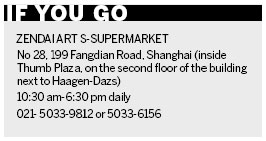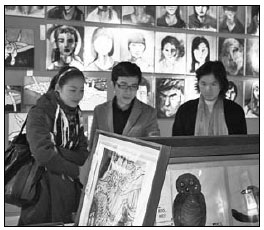Bringing art down to earth
|
The supermarket approach to art means there's something here for most tastes and budgets. Provided to China Daily |
Shanghai
The typical museum-goer will pick up the difference between a public art gallery and this private one at first sight - each of the hundreds of art pieces displayed in the 3,000-square-meter space has a price tag attached.
It's not called "Art Supermarket" for nothing. Equipped with a clerk at the exit, Zendai Art S-Supermarket is for those art lovers that are not satisfied by just gazing at the art - they would also like to bring some home.
"For spectators, especially Chinese ones, art is this thing that sits up on high, but what we're doing is to drag it down into the world, to every consumer's bedroom or wherever they want to place the art," says Zhu Jingyi, director of the art supermarket.
Zhu says that with some private art galleries and auction houses occupying China's high-end contemporary art market, there's still a lot of space left in the mid- to low-end markets. "Everybody is welcome here, everybody, including those who just come for browsing rather than buying," he says.

That probably explains why, on any given afternoon, you can find an art student or two lingering to paint what's hung on the wall.
Zhu says this museum-turned-supermarket opened just two years ago. The fact that it used to be a two-floor museum makes it more like a gallery than a shop.
Art works range from woodcarvings to oil paintings to ceramic works, and come from professional artists, part-time artists or students from colleges of fine arts. "We actually don't care about where it comes from as long as the stuff is good," says Zhu.
Painter Guo Yisheng has been supplying the art supermarket for more than a year, but recently he realized his paintings do not sell as well as those of his wife, Ding Haiwen. Ding, a housewife, started to draw when she got bored and figured that the art supermarket was not elitist when selecting artwork.
"Chinese buyers' tastes are actually predictable," says Zhu. "Those with fusion elements and with a Chinese tone are the most popular ones."
Prices are affordable; around 60 to 70 percent of the works are under 5,000 yuan and 20 to 30 percent range from 5,000 yuan to 50,000 yuan.
"We have two types of buyers - those who want to get something to decorate their homes and the junior collectors," Zhu says.
Ye Tao, a painter who started to supply the art supermarket with his work in February, says around 20 percent of the art for sale has the potential to rise in value in the future.
"The good thing about this art supermarket is that it has a low entry barrier and has transparent price tags," says Ye. "I used to send my paintings to a private gallery and as far as I know, they offer different customers different prices."
China Daily
(China Daily 02/27/2011 page15)















